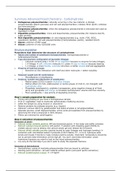Summary
Summary Advanced Food Chemistry - Carbohydrates part
- Course
- Institution
Summary of the course Advanced Food Chemistry - Carbohydrates part (FCH-30806) at Wageningen University. This summary contains the following: - Structure elucidation (sample preparation, extraction, fractionation) - Analysis of carbohydrates (sugar composition, glycosidic linkages, partial degra...
[Show more]



